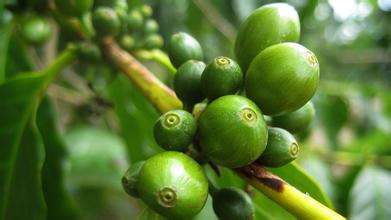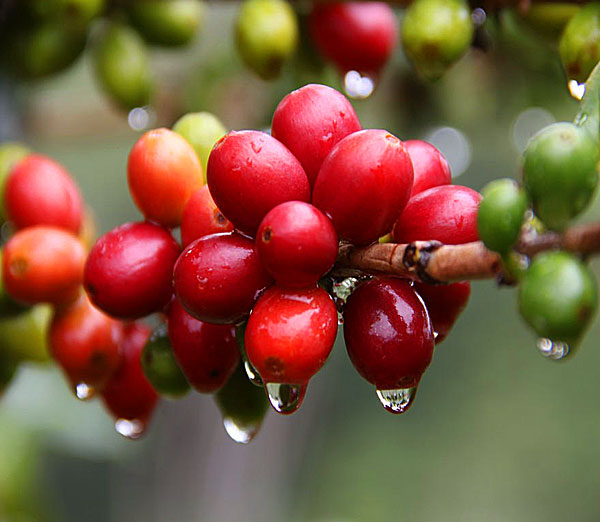Introduction History of Yunnan Coffee, the Old varieties of Yunnan Coffee
Coffee originated in Ethiopia in north-central Africa. It was introduced into the Arabian Peninsula before the 15th century, introduced into Taiwan in 1884 and introduced into Hainan Province in 1908. Coffee was first introduced and planted in Yunnan Province in 1902 by French missionaries in Binchuan County, Yunnan Province, which can be called the introduction of East Road, and the introduction of West Road was introduced and planted by 1908 border people of Yunnan Ruili Jingpo nationality. but at that time, these coffees were only used for viewing and growers' own consumption, and did not carry out large-scale production. It was not until the 1950s that in order to meet the demand for coffee from the Soviet Union and the socialist countries in Eastern Europe, China began to grow coffee commercially, forming two major coffee production bases in Hainan and Yunnan. Hainan mainly produces medium-grain coffee and Yunnan mainly produces small-grain coffee. Coffee has been introduced into China for more than 100 years, and commercial cultivation has been formed for more than 50 years. However, at present, no one has made a systematic and comprehensive investigation on the germplasm resources of various coffee planting areas in Yunnan. In the past 10 years, the planting area of coffee in Yunnan has developed rapidly, and the current planting area has reached 320000 mu. Due to the neglect of the adaptability evaluation of different varieties to the ecological environment of the planting site, and the mixed planting varieties. Resulting in varying degrees of loss in production. The research work of coffee breeding in China lags behind and can not meet the demand for excellent varieties in time. In addition, due to the fluctuation of coffee market price, the coffee area of the whole province has gradually shrunk in recent years. Supported by the key Fund of Yunnan Academy of Agricultural Sciences from 2006 to 2007, we investigated and investigated the main coffee planting areas and some early planting areas in the province, and collected individual plants with excellent growth characters as germplasm resources. the work in the past two years is summarized as follows:
Introduction History of Coffee in Yunnan
According to textual research, the earliest introduction of coffee in Yunnan can be divided into "east and west roads". The east road was carried by the French Catholic missionary "Tian Deneng" through Vietnam and Laos in the French colony at that time to Binchuan Kula plant for its own drinking [1] [2]. According to the field investigation records of our institute in 1981, there are still 24 original species, which are more than 80 years old and still grow healthily. In April 2007, the staff of our research group conducted a field survey, and the original plant no longer exists, but the local villagers have developed and planted more than 30 mu of coffee, which, according to the villagers, began to be planted in the early 1960s, and the provenance is the original 24 old coffee trees. According to Huang Junxiong's "Development and Review of Yunnan Coffee" [3], the structure of this variety is a mixed population of 69% Boubon and 31% Typic. The provenance spread to Hekou, Kaiyuan, Shuangbai and Dayao counties around 1969. We conducted a field survey in Wenbi Township, Dayao County. According to the local villagers, more than 300 mu were developed and planted around 1969, but now only sporadic plants are preserved, and the variety comes from Binchuan Kula.
West Road was introduced by 1908 border people of Jingpo nationality from Myanmar to Ruili Nongxian Village as a courtyard ornamental plant. In the spring of 1952, the scientific and technological staff of our institute discovered and successfully introduced it to Lujiangba. More than 40, 000 mu were planted in Lujiang Dam in the 1960s. Because of its high sensitivity to rust and the harm of longicorn beetles, this variety has been gradually replaced by other varieties, which is now only more than 500 mu, mainly concentrated in Lujiangba, Baoshan, and only sporadically retained or mixed plants in other planting areas. According to Huang Junxiong's "Development and Review of Yunnan Coffee", the structure of this variety is a mixed population of 83.6% Typic and 16.4% Boubon.
With the development and growth of coffee production in our province, the relevant units continue to introduce excellent foreign coffee varieties. Dehong Tropical Agricultural Research Institute introduced rust-resistant variety S288 from India in 1967, and popularized it in 1986 to solve the problem of serious rust in coffee production in hot and humid areas [4]. Since then, excellent foreign coffee varieties such as Katimo series and Mexican series have been introduced, and coffee germplasm resources have been established in 1992, and Katimer series have been introduced and popularized since 1994. Among them, Katimo 7963 has become the main cultivated variety in various coffee producing areas of our province.

Important Notice :
前街咖啡 FrontStreet Coffee has moved to new addredd:
FrontStreet Coffee Address: 315,Donghua East Road,GuangZhou
Tel:020 38364473
- Prev

Development of Coffee in China Coffee production in Yunnan accelerates the development of coffee industry in Yunnan Province
Yunnan Province is the largest coffee bean production base in China. Recently, Yunnan Province has issued opinions to speed up the development of the coffee industry from the aspects of building a high-quality coffee bean production base, building leading enterprises, and upgrading the level of science and technology. The Coffee Industry Development Plan (20102020) issued by Yunnan Province proposes to build Yunnan into the raw material base of the world's high-quality coffee beans in the next ten years.
- Next

Office Coffee Culture Chinese Coffee Culture White-collar Coffee Culture Coffee Culture
For a more respectable Office, there are always two shiny coffee pots, and coffee is provided free of charge around the clock. A little more particular, there will even be a small coffee shop for employees to enjoy during the break. As a result, the jingling music of stirring coffee with a metal spoon here has become a kind of corporate culture. Free coffee, for
Related
- How did the Salvadoran coffee industry develop in Central America?
- What exactly does the golden cup extraction of coffee mean?
- The Origin of Coffee flower
- [2023 Starbucks World Earth Day] there are more meaningful things besides free Starbucks coffee!
- What kind of coffee is there in Spain? 9 Flavors of Spanish Coffee
- Aromatic African coffee| Kenya's coffee culture and historical production area
- Liberica Coffee Bean knowledge: the characteristics of Liberian Coffee beans of the three original species of Coffee beans
- The origin and formula of Spanish latte introduces the taste characteristics of Bombon coffee in Valencia, Spain.
- How to adjust the solution of over-extracted coffee
- What is the tasting period of coffee beans? What is the period of coffee and beans? How should coffee wake up and raise beans?

